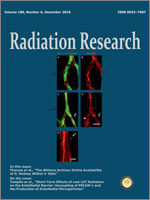We performed studies on pulse radiolysis of highly transparent and shape-stable hydrogels of hydroxypropyl cellulose (HPC) that were prepared using a radiation-crosslinking technique. Several fundamental aspects of radiation-induced chemical reactions in the hydrogels were investigated. With radiation doses less than 1 kGy, degradation of the HPC matrix was not observed. The rate constants of the HPC composing the matrix, with two water decomposition radicals [hydroxyl radical (•OH) and hydrated electron ( )] in the gels, were determined to be 4.5 × 109 and 1.8 × 107 M−1 s−1, respectively. Direct ionization of HPC in the matrix slightly increased the initial yield of
)] in the gels, were determined to be 4.5 × 109 and 1.8 × 107 M−1 s−1, respectively. Direct ionization of HPC in the matrix slightly increased the initial yield of  , but the additionally produced amount of
, but the additionally produced amount of  disappeared immediately within 200 ps, indicating fast recombination of
disappeared immediately within 200 ps, indicating fast recombination of  with hole radicals on HPC or on surrounding hydration water molecules. Reactions of
with hole radicals on HPC or on surrounding hydration water molecules. Reactions of  with nitrous oxide (N2O) and nitromethane (CH3NO2) were also examined. Decay of
with nitrous oxide (N2O) and nitromethane (CH3NO2) were also examined. Decay of  due to scavenging by N2O and CH3NO2 were both slower in hydrogels than in aqueous solutions, showing slower diffusions of the reactants in the gel matrix. The degree of decrease in the decay rate was more effective for N2O than for CH3NO2, revealing lower solubility of N2O in gel than in water. It is known that in viscous solvents, such as ethylene glycol, CH3NO2 exhibits a transient effect, which is a fast reaction over the contact distance of reactants and occurs without diffusions of reactants. However, such an effect was not observed in the hydrogel used in the current study. In addition, the initial yield of
due to scavenging by N2O and CH3NO2 were both slower in hydrogels than in aqueous solutions, showing slower diffusions of the reactants in the gel matrix. The degree of decrease in the decay rate was more effective for N2O than for CH3NO2, revealing lower solubility of N2O in gel than in water. It is known that in viscous solvents, such as ethylene glycol, CH3NO2 exhibits a transient effect, which is a fast reaction over the contact distance of reactants and occurs without diffusions of reactants. However, such an effect was not observed in the hydrogel used in the current study. In addition, the initial yield of  , which is affected by the amount of the scavenged precursor of
, which is affected by the amount of the scavenged precursor of  , in hydrogel containing N2O was slightly higher than that in water containing N2O, and the same tendency was found for CH3NO2.
, in hydrogel containing N2O was slightly higher than that in water containing N2O, and the same tendency was found for CH3NO2.
How to translate text using browser tools
21 November 2016
Radiation-Induced Chemical Reactions in Hydrogel of Hydroxypropyl Cellulose (HPC): A Pulse Radiolysis Study
Shinichi Yamashita,
Jun Ma,
Jean-Louis Marignier,
Akihiro Hiroki,
Mitsumasa Taguchi,
Mehran Mostafavi,
Yosuke Katsumura
ACCESS THE FULL ARTICLE

Radiation Research
Vol. 186 • No. 6
December 2016
Vol. 186 • No. 6
December 2016




